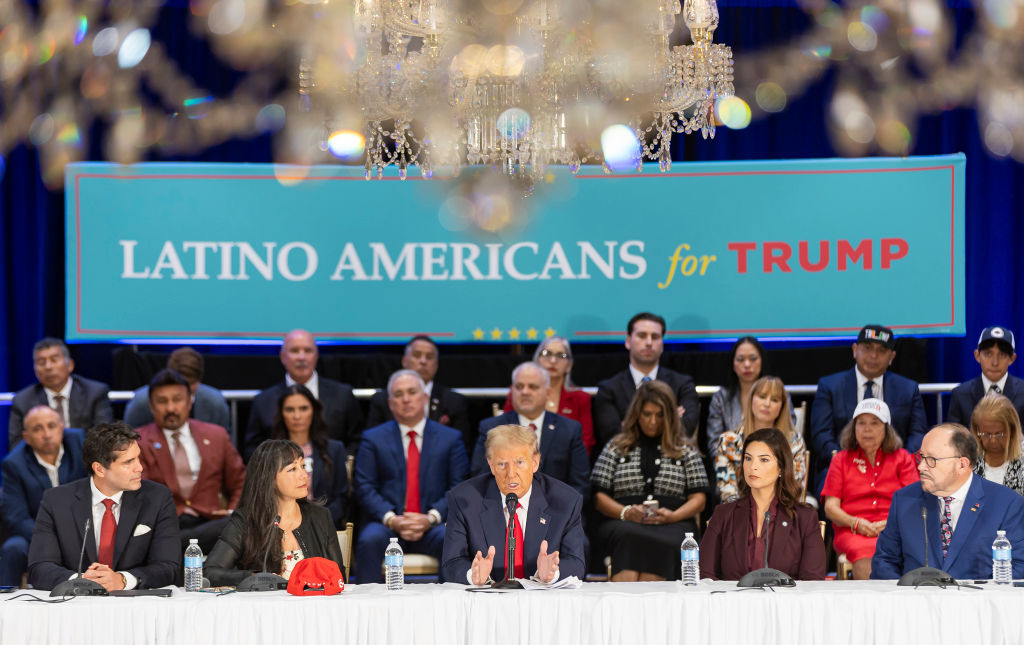In less than two weeks, we will find out whether the inroads Donald Trump made with Latino voters in 2020 were an anomaly—or a sign of a deeper realignment. Yet the votes Latinos cast this November will tell us more about the way Latinos view themselves in America rather than the way they see Trump.
[time-brightcove not-tgx=”true”]
As Trump has focused the nation’s eyes on remaining fearfully fixated on migrants, a growing number of Latinos have joined the “send them back” chants, perfectly blending into the conservative masses purporting to display patriotism. Among the MAGA crowds, behind their American flags, or inside their homes, many Latinos seem to be finding a sense of belonging in Trumpism’s othering. At the end of the day, nothing is more patriotic than sharing a common enemy.
But what happens when the police flood lights burst on and the ICE sirens blare under a second Trump Administration? What happens when Trump’s wall comes up even higher and the nation’s eyes turn on their neighbors? Who becomes “the other” now?
According to a recent New York Times/ Siena College poll, a majority of Latinos, including those who are foreign-born, are not insulted by Donald Trump’s anti-immigrant rhetoric. In fact, a majority of Latinos don’t believe Trump is talking about them when he criminalizes migrants.
In fact, it is understandable that a segment of Latinos feels more detached from their homelands and their immigrant roots. Today’s Latino population is more Americanized and assimilated than ever before. Third-generation Latinos are now the fastest growing segment of Latinos in the country, which means the majority of the Latino electorate is now U.S.-born and predominately English-speaking. Many no longer see themselves reflected in the immigrant story—a story that provided a collective sense of allegiance and solidarity for generations of Latinos that once felt foreign in American lands. Many, simply, just see themselves as Americans.
The question is: how does Trump see them? “You guys are the same as me,” Donald Trump recently told a group of Latino and Afro-Latino barbershop patrons during a campaign stop in the Bronx. “It’s the same stuff. We were born the same way…” Trump continued, facing a group of brown men that were looking at him with the utmost admiration.
Read More: We’re Missing the Point About Latino Voters
Therein lies the power of Trumpism: In its transactional ability to convince a group of minorities that they are part of the the fight against the “other.” While this is a powerful political strategy, let’s not forget that Trump’s own record shows that he has never believed that Black and Latinos are, well, the “same” as him.
In the 1970’s the Department of Justice sued Trump’s real estate company for discriminating against renters of color. While the lawsuit ended in a settlement, testimony shows that rental applications filled by Black people were marked with the letter “C” for “colored.” By 2011, Trump was already fueling birtherism, falsely implying President Obama wasn’t born in the U.S. A few years later, Trump launched his 2016 presidential campaign by criminalizing Mexican immigrants. That same year, he implied that Gonzalo Curiel, the U.S-born judge overseeing the fraud case against Trump University in San Diego, couldn’t be impartial because he was “Hispanic” and “Mexican.” According to a recent report from The Atlantic, during his presidency, Trump allegedly said “It doesn’t cost 60,000 bucks to bury a f***ing Mexican!,” while referring to fallen Army soldier Vanessa Guillen.
Now, threatened by the image of a Black woman in power, Trump spends his days calling Vice President Harris “lazy,” “stupid,” and “crazy,” while his immigration advisor, Stephen Miller, looks at America’s evolving diversity with the same innate horror he expressed as a 16-year old student in California—then, already calling for Latinos to assimilate.
So, what degree of assimilation can prove our “Americanness” to Trumpism? According to Dr. Celia Lacayo, from UCLA’s Chicano Studies Research Center, the white gaze will never fully accept Latinos as their equal. Dr. Lacayo calls this the “perpetual inferiority” theory, which underscores a tendency among white people to see Latinos as a non-white racial group that passes down their “deficient” culture through generations, essentially making us unable to progress, adapt and change. In other words, it is the belief that Latinos will never fully assimilate into American culture.
Undeniably, the perpetual inferiority theory is hard to quantify; but when Trump is in his element, when he’s in his comfort zone—when his tone shifts from courting to affirming—the words speak for themselves. There’s a reason why, amid a nearly all-white campaign audience in Minnesota in 2020, Trump looked at his crowd and vocalized the words he couldn’t get himself to utter in the Bronx: “You have good genes.” The white crowd erupted. They knew they weren’t just the same. They knew they were superior.
In the final days of this election season, some Latinos will continue to fervently join the chorus of “send them back,” driven by the delusion that they would be safe in Trump’s America. But how would Trump determine who is undocumented? If Trump wins, these Latinos will quickly find out that his promise to enact the biggest deportation program in American history will inevitably unleash mass-scale racial profiling, putting a target on their back.
In that version of America, Trump isn’t “the same” as us—last names, slight accents, skin color, or ancestry serve as distinguishing indicators. In that version of America, it’s not up to us to decide how close we are to our immigrant roots—it’s up to them. In that version of America, most of us end up walking freely through security check-points as we hold our U.S. passports, while we witness others being placed inside ICE trucks. The only thing separating us is thin air, and luck.
Only then will we understand that we, too, were always “them.”

